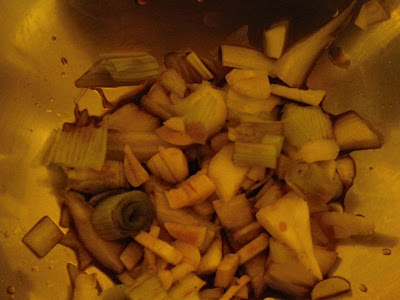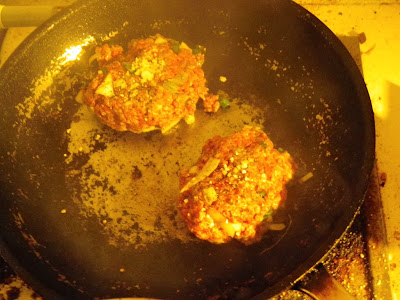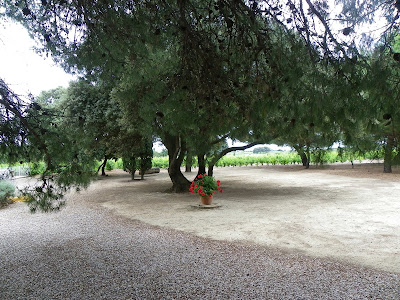The nice folks at
Hérault Tourisme were at it again, and the invitation went around the Usual Suspects in the English-language media here to start our Pentecost weekend a day early with a trip to Frontignan. Checking the map, I saw that it was a few kilometers down the A9 to the southwest, on the water just before you get to Sète. There was some info on
Wikipedia, and a bit more on the
town's tourism site, including a nice
history page which mentions that it was the base for the construction of Sète as a port under Louis XIV and that it has a church from the 12th to 14th centuries in the middle of town.
The idea was that we'd start the day with a nature walk, then visit a winery, have lunch there, and top it all off with a visit to a spa whose water comes from an ancient hot spring. As he drove me down there, Peter, from
the Languedoc Page, reminded me that a lot of the local waterfront communities are quite new, having been developed from the ground up as vacation destinations for French people under Charles de Gaulle after malaria had been eradicated in the area. This explains the hideous architecture found in most of them, as well as the fact that, according to Peter, a lot of the cheapo apartment buildings are falling apart by now.
Frontignan, though, has been in business since the Greeks, who did a lot of business up and down this part of the Mediterranean, and the Romans, who noted that the Greeks had encouraged viticulture and beefed up what they'd started. Frontignan has been famous from time immemorial for its Muscat wine, which, despite being one of the most famous wines produced around here, I'd never tasted, although Thomas Jefferson apparently raved about it. Other locations in France grow muscat grapes, but none of the other muscat wines are as famous as Frontignan's.
Still, as we noted, arriving a bit early and grabbing a coffee at a bakery, the town's not much to look at. The church does rear up noticeably, but other than that there's not much charm. Recognizing that, the local tourist folks have taken a different tack. We drove out to one of the tourist offices (the other is opposite the church) and joined up with our companions for the day. Peter once owned a boat in which he sailed up and down the coast, and recognized the harbor as one he'd berthed in. The office was hung with pictures of the local shore birds and some very impressive underwater photography of some of the local fish and crustaceans, including a great shot of a crab hanging out on the forehead of a fish, who looked nonplussed. There are also, apparently, seahorses out there somewhere.
Our nature guide, Jacques Guiraud, and his assistant arrived, and we drove out into the countryside. My Michelin map notes a Guardiole Mountain behind the town, and that's where we were headed. One thing you notice about Jaqui, as he insists on being called, is his almost manic enthusiasm, and after a while, his deep knowledge, as he starts pointing out plants along the way.
These, for instance, are from the nightshade family, and, he noted, of partcular danger to kids because they think they look like candy. Apparently the British call them "lords and ladies," and as you can see, they're just beginning to ripen, and get quite red at maturity. Other plants along the way included a very big bush whose name I didn't catch, apparently introduced by the Romans because the highly toxic berries are used in leather curing, juniper trees, actual wild asparagus, fennel, a little yellow flower called
immortelle, which he insisted was used in curry (it did have an appealing odor, but it's not from any curry mixture I could identify, so maybe it's the secret of French curry, which I've never had), and an herb called rue, which he said was made into a tea for women who wanted abortions. I have no idea how they got it down: the smell of the leaf almost made me abort my breakfast.
As we got further up the hill, the limestone underneath was visible.
There were apparently prehistoric inhabitants up here, and there's also an ancient abbey in ruins somewhere in the neighborhood, but the best we got to see was a World War II bunker meant to defend the petroleum industry which once existed in town.
When we got fairly high up (although this ain't Everest: my map shows the peak at 151 meters above sea level, with two others at 216 and 142 along the rise) we paused at a "panorama" as Jacqui got out some water, we enjoyed some rather dry little cookies from a
local bakery called
pavois de Frontignan made with -- what else? -- Muscat, and he explained what we were looking at.
Not that you can see it in my non-Ansel-Adams-quality photo here, but most of that green downhill from the evergreens is vines, and the red roofs of Frontignan (right) and Le Peyrade (left) sit behind a slit in the water which is the Rhône-Sète Canal. Sète itself is out of sight to the left. From here we descended, stopping so Jacqui could pull a cicada-larva shell off of a tree to explain how they emerge yearly after an insanely long gestation period. He'd already explained how the cicada (
le cigale) is an index of both time and temperature, and that the sound is made by the male, indicating he's ready to mate again, something which happens for 15 minutes, after which he takes 15 minutes off, and he's ready to rock once more.
(A note to the nice people at the Frontignan Tourist Agency: although
le cigale is the
much-commercialized and instantly-recognizable symbol of Provence, neither the Gardiole hills nor, of course, Frontignan is in Provence, which gets all too much recognition as it is. Thus, you might want to change the English text on p. 9 of your
guide touristique, which begins "Out in the open air. High up on Provence's rocky
garrigues, you can see Frontignan from a different angle
." This may be so, but what we're looking at in that photo is most definitely Languedoc-Roussillon. Neither the French nor the German text makes this mistake, so you're okay there.)
Heading back to the cars, we discovered one of the more bizarre non-natural things in the area: a series of metal tubes welded together. One of the other journalists and I decided it was worth a closeup look, and we figured it to be the frame of an ejector seat, which fell away when the passenger opened his parachute. It wasn't rusted, so it could well have happened recently. Is there a corpse shrouded in parachute silk somewhere up there in the
garrigue? Jacqui wasn't interested: it wasn't nature. Ah, well.
From there we drove to lunch, which was at a winery called Six Terres. There we were given a lecture by the farmer (the owner lives in Paris) about how the grapes are grown. They have two methods, the old-time one...
...where the vines just grow naturally, although the foliage has to be trimmed, and the new method...
...in which, as you can barely make out here, the vines are trained onto wires and the foliage is allowed to grow every which way. This is easier to harvest, but I missed some of the other explanation.
Finally, we sat down to eat, and a bottle of Muscat Sec was uncorked. As we were to find out, Muscat de Frontignan comes in three sorts. Muscat Sec is interesting. The nose ("white flowers," the guy from the 100-year-old co-op, to which Chateau Six Terres belongs, told us) is sweet. Now, as I've noticed, since it's just beginning to be rosé season here and I can taste again, that's the deal with rosé: you get apple, or melon, or strawberry or some combination of fruits and flowers, in the nose, but not at all on the tongue. It's part of why the local rosés fascinate me so much. Muscat Sec does the same thing, but it's very slightly sweet on the tongue. It's...interesting. I'm not sure how much I like it, actually. It does go well with seafood and other local specialties.
The little pies are
tielles sètoises, filled with chopped
seiches, little cuttlefish, cooked with spices. The bread has a black olive tapenade on it, and we've got a bottle of sec, sweet, and grape juice in the shot. We also had other hors'doeuvres.
The tomato "lollipops" had the sesame seeds stuck on with what tasted like honey, and, along with the cherry tomatoes not being all that ripe, weren't particularly successful. Next to them is
tortilla espagnole, the wonderful egg-and-potato dish that's eaten a lot around here, which I should really learn to make. The next shot is shrimp "lollipops" around which has been twirled some potato, which was then deep-fried briefly, and those were good. There's more
tortilla and a bunch of charcuterie, which was excellent. Accompanying them with the sweet Muscat, though, didn't appeal to me much: I found it slightly cloying. Not as much as the newly-introduced Vin Liqueur, at 15% a reproduction of the way Muscat used to be made in the 19th century -- and most likely before -- with a screw-top cap and a nostalgic bottle. It was brown, packed a punch, and was way too sweet for me, although some of those around me made flattering comparisons to sherry, which I can see.
I found myself staring at the nice view from my seat at the table, the red flowers, the spongy layer of pine needles under the dark trees, and the vines at the other end, so I shot it.
This would have been better if it had been less overcast, but you take what you can get.
At any rate, the second half of the trip was about to begin, so we thanked the Frontignan tourism folks, said good-bye to Jacqui, and headed out. Peter and I decided to take a detour back into town to see the church, which sounded more interesting on paper than it turned out to be in the flesh, or rocks, or whatever. I keep forgetting the violent history of religion here, although I live mere blocks from some representations of it, but I'm always disappointed to walk into one of these churches and see how bare they are. This one had modern stained glass in the narrow, slit-like windows, which brightened the interior up nicely, but aside from a carved plaque and a very nice skull and crossbones
memento mori carved from white polished stone and mounted on some black polished stone from the 16th century, and a really neat wooden statue of St. Roch wearing a 16th century stovepipe hat to the right of the altar, there wasn't anything to see. We hopped back into the car and headed to Balaruc-les-bains, where the hot spring spa awaited us.
I wasn't much looking forward to this, since I haven't owned a bathing suit since leaving Texas in 1993. I've never much enjoyed swimming, although lolling around in a pool has its appeal on hot days, and there was definitely no beach in Berlin. I may yet have to get one, since there was that trip to the river last year, and this trip, a suit would have allowed me into the high-tech thermal pool at
O'balia, the upmarket beauty-care and health spa the Hérault Tourisme folks were taking us to. The pool had two levels and a waterfall and currents to swim against and all, and it looked like fun. There was also a bizarre wooden structure the guides took us to which looked out over the Bassin de Thau and its oyster and mussel farms towards Sète. It also shook like crazy when the wind blew, so I abandoned it quickly.
While the others bathed, I sat and read, and soon it was 4 o'clock and time to go. On the way back, Peter made a wrong turn as we got into Montpellier and instead of being able to zip into the front of the huge line of cars heading into town, we were going the other way. He decided to wait the congestion out and we wound up at Carnon Plage, one of his favorite berths during his boating days, an absolutely tasteless collection of cheap restaurants, pizza places, bars, and kebab stands that was, somehow, absolutely perfect. We checked out the beach, and he pointed out landmarks from Sète to the lighthouse south of Port-Camargue, past which lies the real Camargue of white horse and cowboy fame. Somehow the reminder of what French tourism is like for the French -- hanging out on the beach with the kids and then eating mussels and fries for dinner in one of the joints in town -- was a perfect finish to the day. And he was right: two beers later, the traffic jam was all but gone.
(The nature tour is, as I hope I've made clear, quite wonderful, and I suspect it gets better as the summer continues. It's held every Saturday from April to October, costs €5 a head, and the maximum capacity is 30. Jaqui gives the tour in French only: he doesn't speak any English. Reservations are available through his website.)















